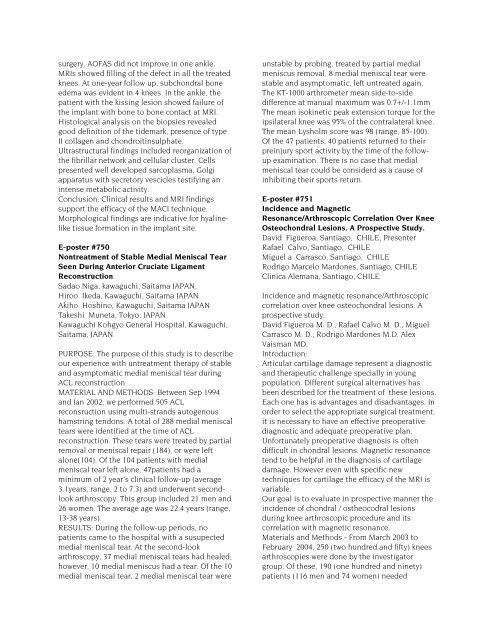POSTER ABSTRACTS - ISAKOS
POSTER ABSTRACTS - ISAKOS
POSTER ABSTRACTS - ISAKOS
Create successful ePaper yourself
Turn your PDF publications into a flip-book with our unique Google optimized e-Paper software.
surgery. AOFAS did not improve in one ankle.<br />
MRIs showed filling of the defect in all the treated<br />
knees. At one-year follow up, subchondral bone<br />
edema was evident in 4 knees. In the ankle, the<br />
patient with the kissing lesion showed failure of<br />
the implant with bone to bone contact at MRI.<br />
Histological analysis on the biopsies revealed<br />
good definition of the tidemark, presence of type<br />
II collagen and chondroitinsulphate.<br />
Ultrastructural findings included reorganization of<br />
the fibrillar network and cellular cluster. Cells<br />
presented well developed sarcoplasma, Golgi<br />
apparatus with secretory vescicles testifying an<br />
intense metabolic activity.<br />
Conclusion: Clinical results and MRI findings<br />
support the efficacy of the MACI technique.<br />
Morphological findings are indicative for hyalinelike<br />
tissue formation in the implant site.<br />
E-poster #750<br />
Nontreatment of Stable Medial Meniscal Tear<br />
Seen During Anterior Cruciate Ligament<br />
Reconstruction<br />
Sadao Niga, kawaguchi, Saitama JAPAN,<br />
Hiroo Ikeda, Kawaguchi, Saitama JAPAN<br />
Akiho Hoshino, Kawaguchi, Saitama JAPAN<br />
Takeshi Muneta, Tokyo, JAPAN<br />
Kawaguchi Kohgyo General Hospital, Kawaguchi,<br />
Saitama, JAPAN<br />
PURPOSE: The purpose of this study is to describe<br />
our experience with untreatment therapy of stable<br />
and asymptomatic medial meniscal tear during<br />
ACL reconstruction.<br />
MATERIAL AND METHODS: Between Sep 1994<br />
and Jan 2002, we performed 505 ACL<br />
reconsruction using multi-strands autogenous<br />
hamstring tendons. A total of 288 medial meniscal<br />
tears were identified at the time of ACL<br />
reconstruction. These tears were treated by partial<br />
removal or meniscal repair (184), or were left<br />
alone(104). Of the 104 patients with medial<br />
meniscal tear left alone, 47patients had a<br />
minimum of 2 year's clinical follow-up (average<br />
3.1years, range, 2 to 7.3) and underwent secondlook<br />
arthroscopy. This group included 21 men and<br />
26 women. The average age was 22.4 years (range,<br />
13-38 years).<br />
RESULTS: During the follow-up periods, no<br />
patients came to the hospital with a susupected<br />
medial meniscal tear. At the second-look<br />
arthroscopy, 37 medial meniscal tears had healed;<br />
however, 10 medial meniscus had a tear. Of the 10<br />
medial meniscal tear, 2 medial meniscal tear were<br />
unstable by probing, treated by partial medial<br />
meniscus removal, 8 medial meniscal tear were<br />
stable and asymptomatic, left untreated again.<br />
The KT-1000 arthrometer mean side-to-side<br />
difference at manual maximum was 0.7+/-1.1mm<br />
The mean isokinetic peak extension torque for the<br />
ipsilateral knee was 95% of the contralateral knee.<br />
The mean Lysholm score was 98 (range, 85-100).<br />
Of the 47 patients, 40 patients returned to their<br />
preinjury sport activity by the time of the followup<br />
examination. There is no case that medial<br />
meniscal tear could be considerd as a cause of<br />
inhibiting their sports return.<br />
E-poster #751<br />
Incidence and Magnetic<br />
Resonance/Arthroscopic Correlation Over Knee<br />
Osteochondral Lesions. A Prospective Study.<br />
David Figueroa, Santiago, CHILE, Presenter<br />
Rafael Calvo, Santiago, CHILE<br />
Miguel a Carrasco, Santiago, CHILE<br />
Rodrigo Marcelo Mardones, Santiago, CHILE<br />
Clinica Alemana, Santiago, CHILE<br />
Incidence and magnetic resonance/Arthroscopic<br />
correlation over knee osteochondral lesions. A<br />
prospective study.<br />
David Figueroa M. D., Rafael Calvo M. D., Miguel<br />
Carrasco M. D., Rodrigo Mardones M.D. Alex<br />
Vaisman MD.<br />
Introduction:<br />
Articular cartilage damage represent a diagnostic<br />
and therapeutic challenge specially in young<br />
population. Different surgical alternatives has<br />
been described for the treatment of these lesions.<br />
Each one has is advantages and disadvantages. In<br />
order to select the appropriate surgical treatment,<br />
it is necessary to have an effective preoperative<br />
diagnostic and adequate preoperative plan.<br />
Unfortunately preoperative diagnosis is often<br />
difficult in chondral lesions. Magnetic resonance<br />
tend to be helpful in the diagnosis of cartilage<br />
damage. However even with specific new<br />
techniques for cartilage the efficacy of the MRI is<br />
variable.<br />
Our goal is to evaluate in prospective manner the<br />
incidence of chondral / ostheocodral lesions<br />
during knee arthroscopic procedure and its<br />
correlation with magnetic resonance.<br />
Materials and Methods.- From March 2003 to<br />
February 2004, 250 (two hundred and fifty) knees<br />
arthroscopies were done by the investigator<br />
group. Of these, 190 (one hundred and ninety)<br />
patients (116 men and 74 women) needed
















